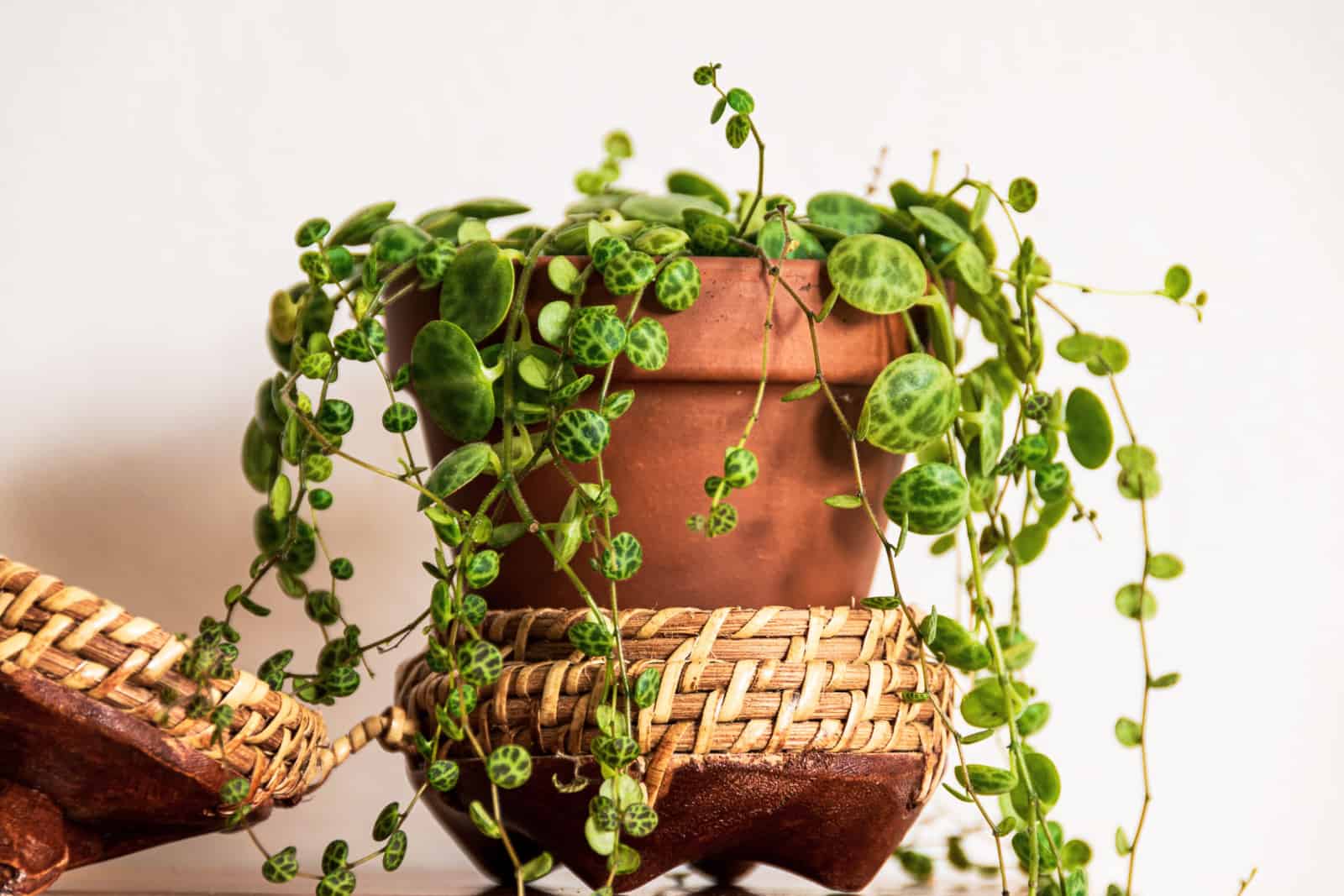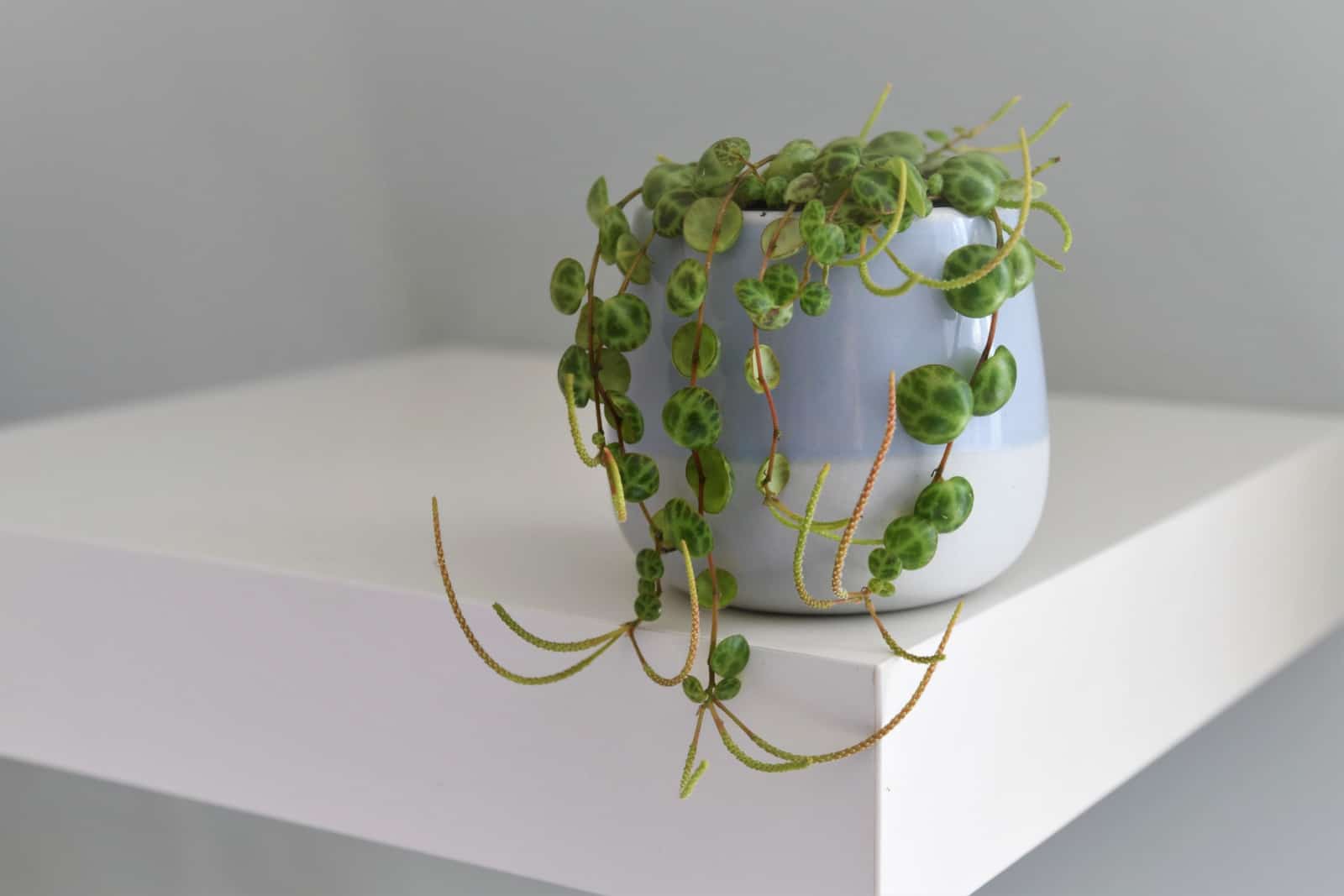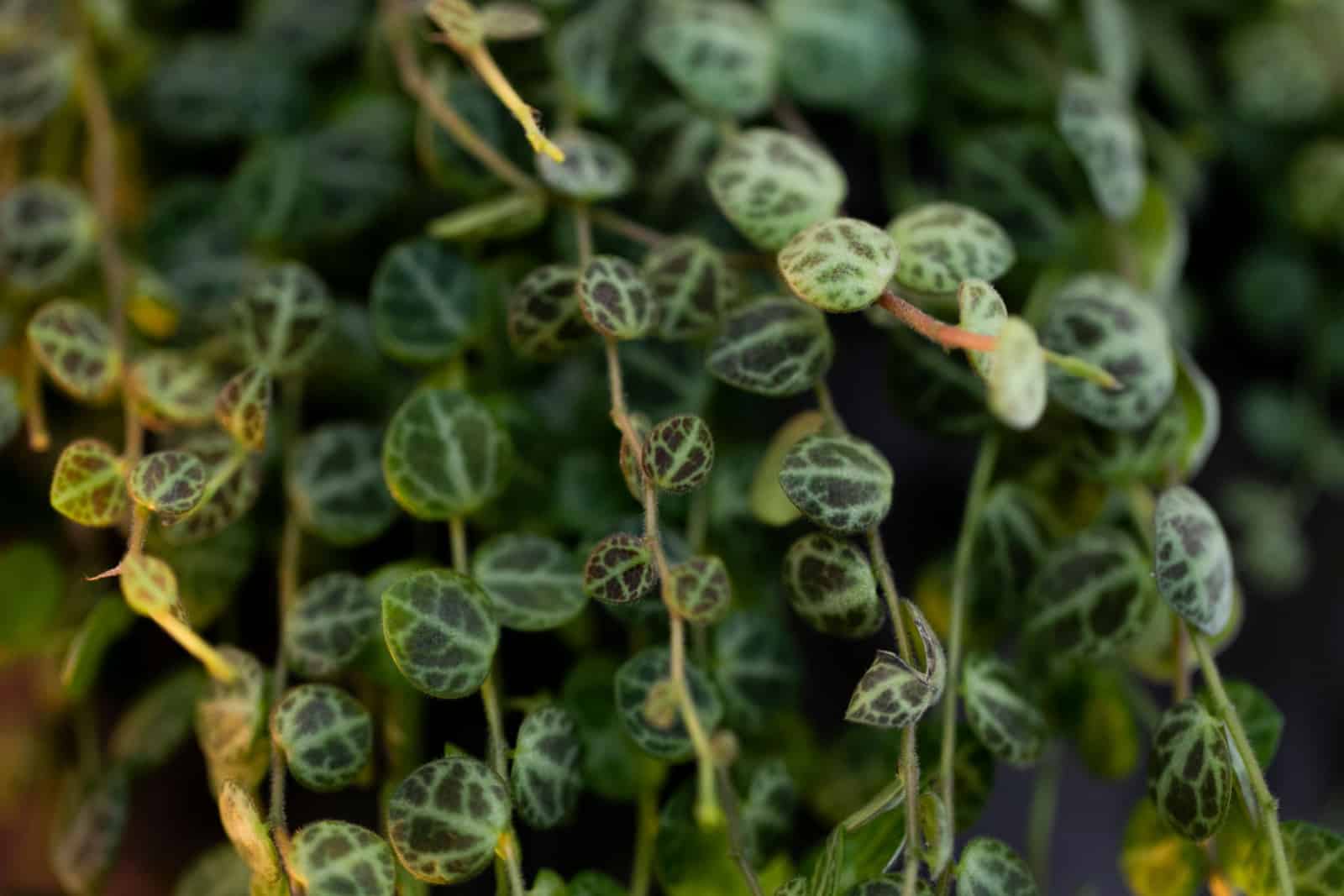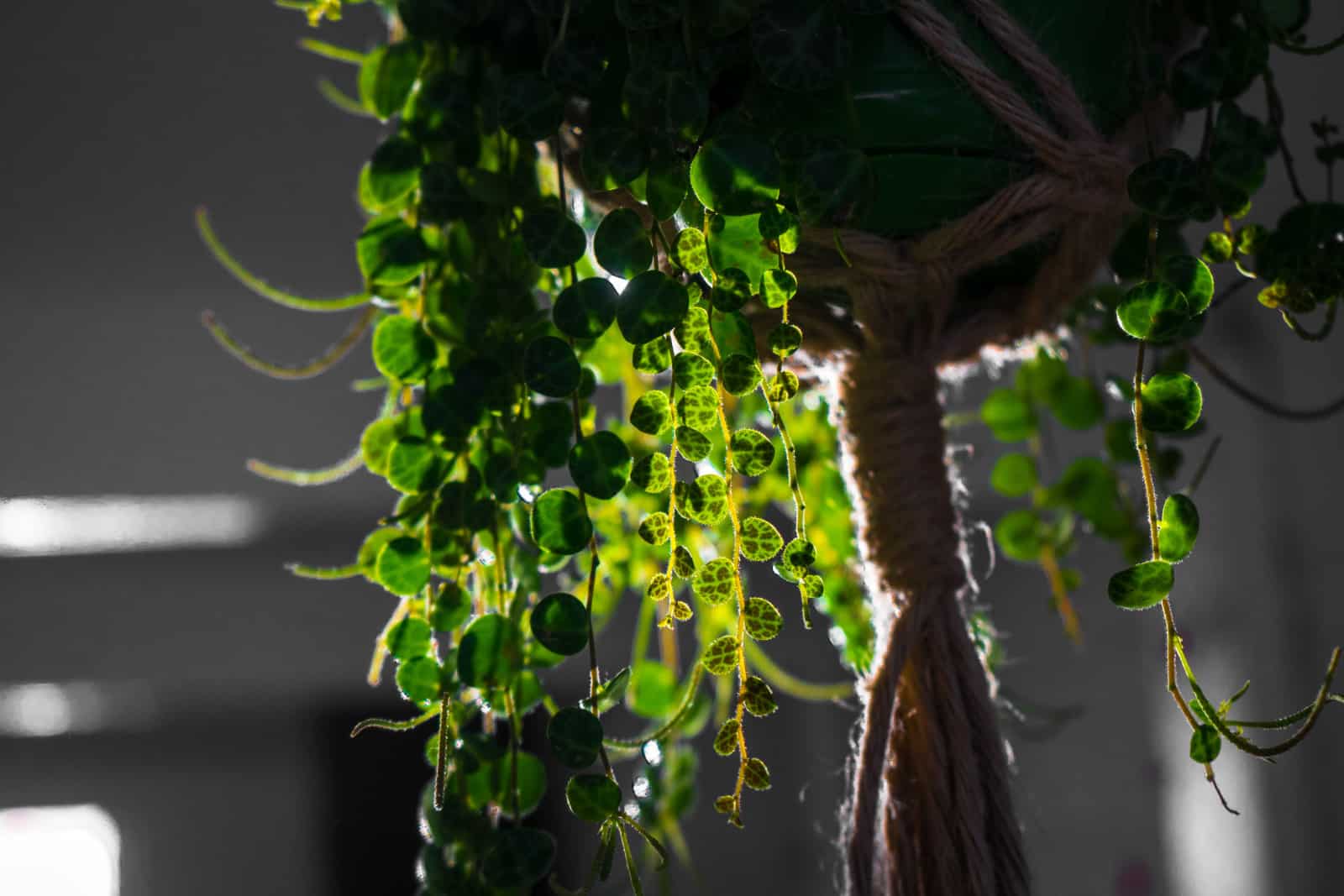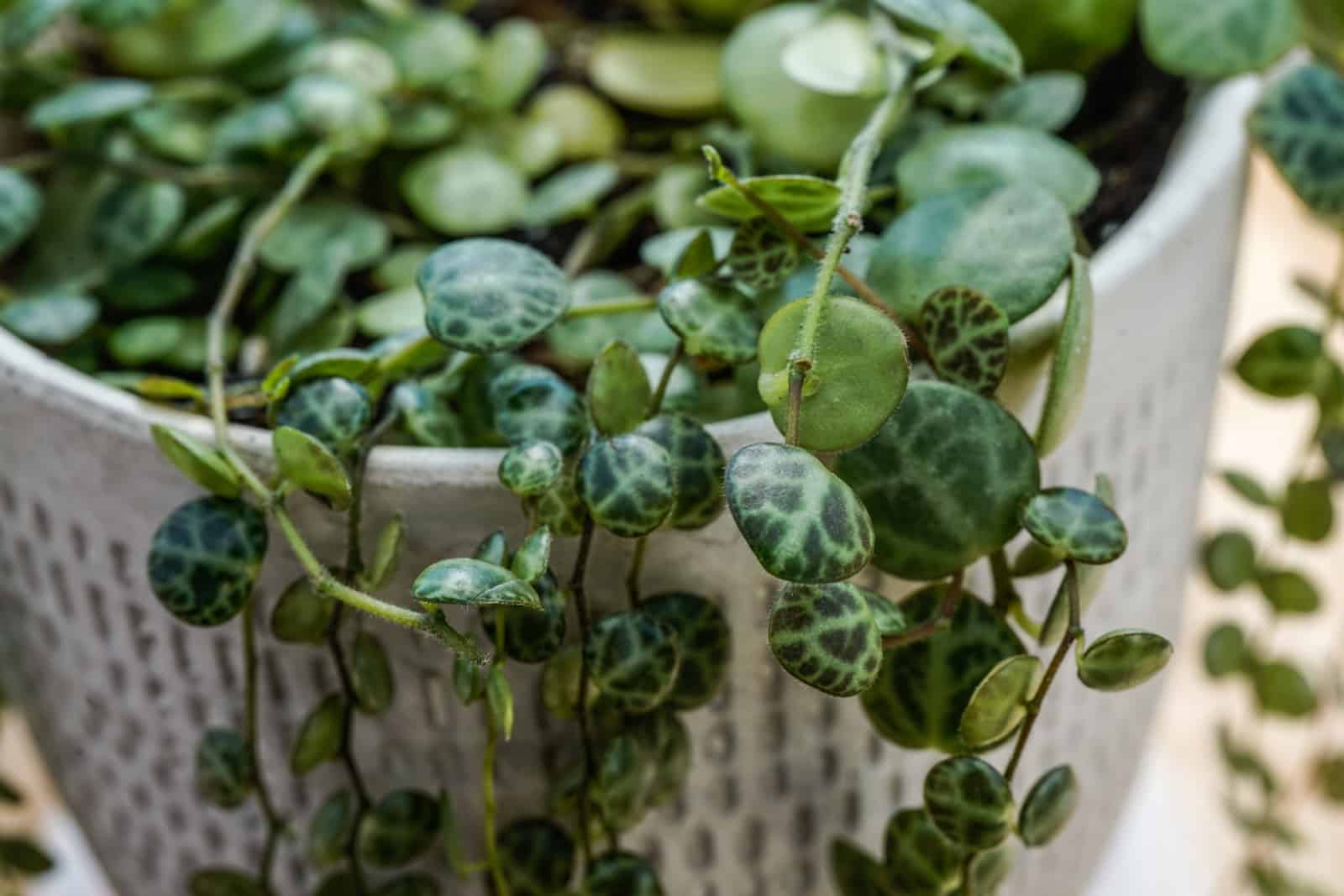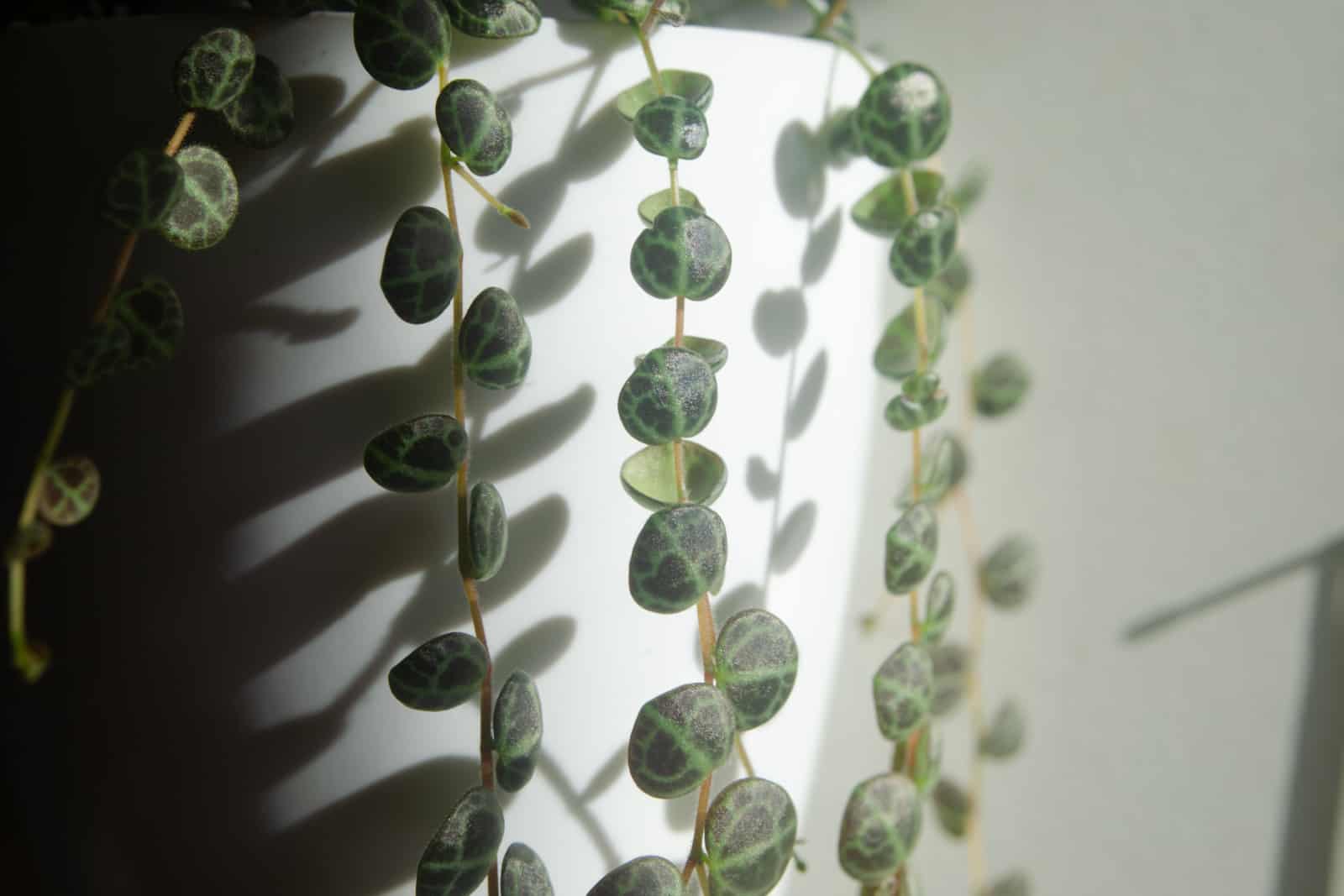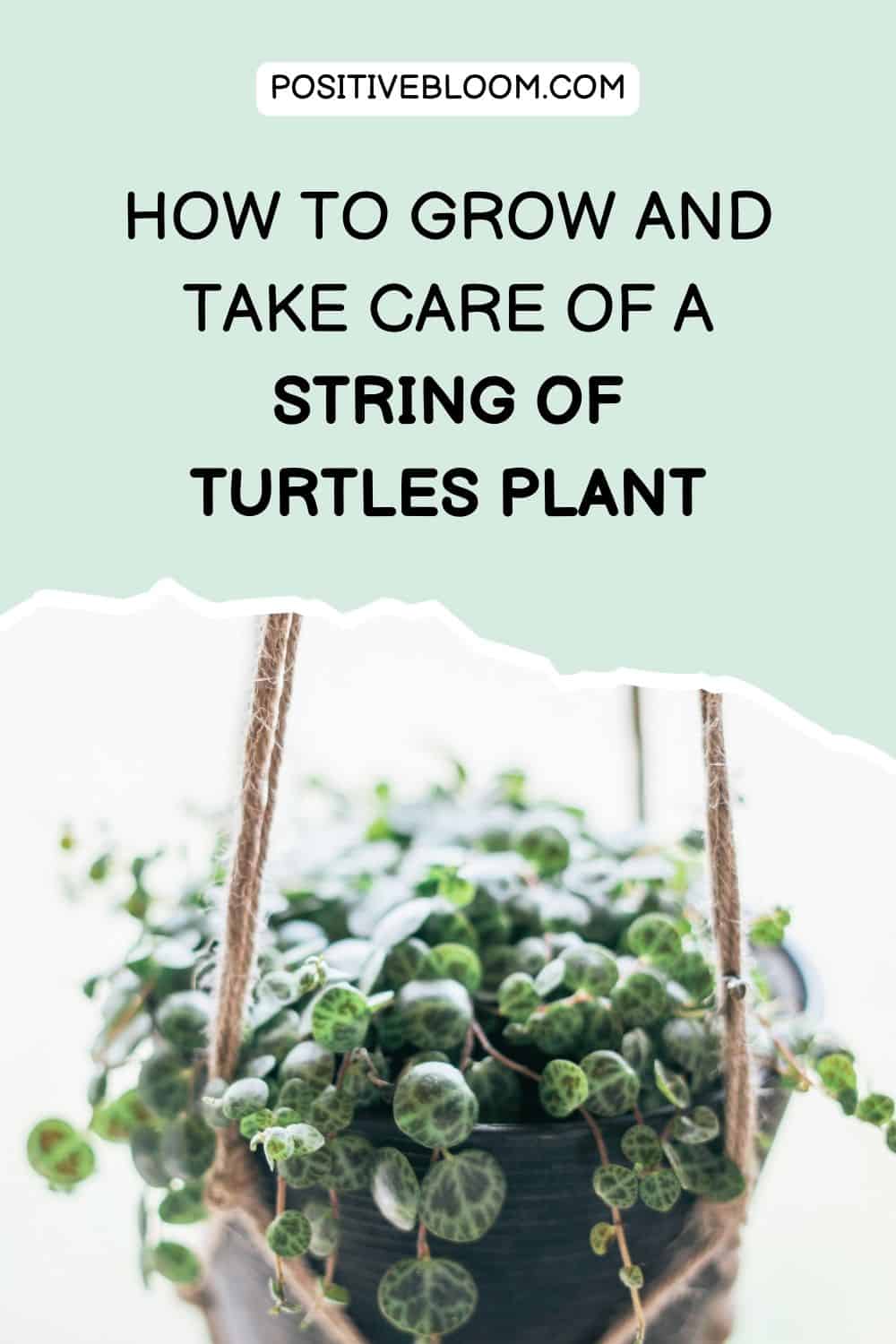If you like turtles, then you are definitely going to love the lovely plant known as the String of Turtles. Its green leaves look like tiny turtles climbing along a string, hence the name!
The String of Turtles plant, also known as Peperomia prostrata, is a semi-succulent type of Peperomia plant that is relatively easy to take care of, which is why these low-maintenance plants are also beginner-friendly.
Here is some of the basic plant info:
[table id=506 /]
Now, let’s talk more about this lovely plant!
What Is The String Of Turtles?
The String of Turtles is a tropical plant that originates from the deep rainforests of Brazil. It belongs to the Peperomia genus, so you can grow them together with other types of Peperomia houseplants because they have similar plant care.
This plant is special because of its unique-looking leaves, which are small, compact, and green with some creamy white variegations. They look like tiny turtle shells!
What’s also interesting is that each of these leaves is attached to long, vine-like stems, so it looks like the little turtles are climbing up and down the strings. The stems have a light green to orange color and they can grow very long, which is why these hanging plants are perfect to grow in hanging baskets.
This semi-succulent is a slow grower — it reaches maturity after 3 to 5 years. The plant stays relatively small, it’s just their long vines that make them seem taller.
In their native habitat they can even grow as an epiphyte, along with other plants that are now also commonly grown indoors such as the Hoya Gracilis. So, just like they can spread its vines on trees, you can train them to climb all over the walls or bookshelves.
The String of Turtles can also be used for terrariums, it would be like turtles are living in there!
String Of Turtles Care Tips
As we mentioned, these indoor plants are relatively easy to take care of. Unlike many tropical plants, the String of Turtle does not require frequent watering — it can even go some time without a drop of water!
Keep them out of direct sunlight and provide them with moderate temperatures and loamy, well-draining soil to have a healthy plant. Nonetheless, we are going to discuss their plant care in more detail.
Light Requirements
Provide your plant with bright indirect light to keep it happy and healthy. You should not expose it to direct sun, especially on a hot summer day because they will easily be damaged and those little turtles might get burned!
However, you can expose it to some direct light in the morning.
It is important that the light reaches all parts, including the top of the plant as well. Sometimes when this plant is put on a high shelf, the light is not going to reach the entire plant, which can result in stunted growth.
Just don’t let the plant sit in an area with low light or they will become leggy and you won’t see any new growth. If you are having issues finding the right spot for your String of Turtles you can invest in some grow lights (you can find them very cheap on Etsy!).
Soil Requirements
Well-draining soil is essential for succulent plants because they hate having a lot of water around their roots. If that does happen, the roots will likely rot.
You will therefore require a potting mix made of components that promote drainage.
Aeration is another prerequisite when it comes to soil. You must add materials that enhance aeration because airflow is necessary for good root development.
You can either buy a premade succulent mix or create your own DIY version. I always choose the second option because it’s more enjoyable and I prefer to know what’s inside.
You can create your own succulent soil mix by combining a variety of ingredients, but I’ll list a couple that I found to be effective for my succulents.
The regular potting soil that you can buy at supermarkets is the first item you need. Then you’ll need materials that help with drainage and aeration; for these I suggest perlite, pumice, gardening sand, sphagnum moss, or orchid bark.
For instance, 2 parts potting soil, 1 part gardening sand, and 1 part perlite can be combined to create a good mixture. Two parts gardening sand, two parts potting soil, and one part perlite make up another fantastic mixture.
Water Requirements
Watering is probably the most important step in the Peperomia plant’s care guide. Unfortunately, overwatering is a huge issue when it comes to succulents because they don’t enjoy frequent watering. This often leads to root rot, which is a fungal disease that can easily ruin your entire plant.
First of all, you have to make sure that the plant is growing in the right environment. Having pots with drainage holes in the bottom helps tremendously with this issue. Next is the watering method you use.
I would advise you to water your plant thoroughly until the water starts coming out of the drainage holes. Then you should wait until a few inches of soil have dried before watering again. If so, water the plant again. Otherwise you can skip watering for a few days.
Even if you let the soil completely dry out, it wouldn’t be such a big deal because these plants store a lot of water in their leaves. However, don’t let them sit in bone-dry soil for too long as it can lead to underwatering!
Read also: Signs Of An Underwatered String Of Hearts And How To Fix It
Temperature Requirements
This succulent could be grown outside, but it would mostly depend on the temperature range in your region.
You won’t be able to enjoy these adorable plants on your patio or in your yard if you live in a colder area because they are not frost-tolerant.
Interestingly, these plants can survive in lower temperatures, but they will perish if the temperature falls below 50 degrees Fahrenheit.
These succulents will flourish in normal temperatures when grown indoors (68 to 75 degrees Fahrenheit). So, if it’s comfortable for you, it will also be comfortable for your plant.
Keep your SOT away from drafts and fireplaces, though.
Humidity Requirements
Understanding the humidity needs of succulent plants may be a little challenging. Some of these plants can survive in homes with humidity levels that are greater or lower than normal, but any extremes will harm the plants.
SOT plants prefer humidity levels that are around 40%, so if you live in a dry area, investing in a humidifier isn’t a bad idea (you can find cheap ones on Amazon!).
My primary goal in increasing humidity is to provide my tropical houseplants with a better habitat. Average humidity is ideal for your plant, but don’t allow it to drop too low or your plant may not develop as quickly as it should.
There are several alternatives that you can use to boost humidity. This includes creating a pebble tray, misting regularly, or grouping the plants. If you are going to grow them in succulent terrariums, then this shouldn’t be an issue.
Fertilizer Requirements
I fertilize my SOT plant every other week with a diluted houseplant fertilizer, and it is happier than ever!
Adding fertilizers during the growing season will accelerate the growth rate, making the plant grow vigorously and produce even more turtle leaves. When it comes to fertilizers, I advise applying a well-balanced, water-soluble fertilizer. Plant food should be diluted to half strength to prevent overfeeding.
You should also avoid fertilizing them during the winter months as these plants enter dormancy.
Repotting
As we mentioned, this plant is not a fast grower. Therefore, you won’t have to worry about repotting it every season. Their root growth rate is also relatively low, and it will take some time for them to get root bound.
Even then, the plant enjoys being slightly crowded. However, if the roots start coming out of the drainage holes it is time for repotting.
Prepare a new and slightly larger pot before you begin repotting. Terracotta pots with drainage holes are the best for these types of plants. You will also have to prepare fresh potting soil.
Steps For Repotting
1. You must remove your turtle plant from its pot first. Instead of pulling it, give the pot a little tap to help the plant to wiggle free.
2. Remove the extra soil so you can view the root structure clearly. I handle the roots primarily with my hands.
3. To promote root growth you must untangle the root system. If your plant has too many roots, it could be challenging to do this. I advise making use of a sharp knife in this situation.
4. Insert your plant into the newly filled container after adding roughly one-third of the soil mixture.
5. Continue adding soil until the entire root system is covered.
6. Simply follow the plant care guide to make your plant happy.
Pruning
Regular pruning is what keeps this plant in shape. If you don’t prune them occasionally, they will become tangled and leggy and they will most likely stop growing.
Pruning promotes new vigorous growth and gives your plant that special glow!
Therefore, getting rid of the damaged vines and leaves will make your plant grow and develop. I recommend you use sterile pruning shears or sharp snips when pruning.
Propagation
My favorite part of plant growth is propagation. I enjoy doing it and acquire more plants as a result, saving money on trips to garden centers or nurseries.
Propagating a SOT isn’t difficult, and with some basic knowledge and the correct tools it will almost always be successful.
Stem cuttings are the simplest way to obtain a fresh turtle plant. Cuttings from the plant can be rooted in either water or soil.
Let’s go through propagation step-by-step.
Stem Cuttings In Water
Prepare a fresh pot, a sharp and sterilized knife, and a clear jar or vase before you begin propagating, then follow these steps:
1. Choose a plant vine that is in good health and has a few leaves and nodes attached.
2. Using your knife, cut a part where two leaves connect.
3. Place the stem cutting in the jar or any clear container after filling it with warm water. Ensure that each cutting has a node submerged.
4. Until the plant stem cuttings have formed roots that are about half an inch long, change the water every two to three days.
The cuttings should now be planted in the soil.
Stem Cuttings In Soil
String of Turtle plants can also be propagated without the cutting being placed in water. The stem cuttings are taken using the same procedure.
Here is an example of how to plant stem cuttings in soil:
1. Dig a tiny hole in the fresh soil mixture, then place the newly cut or rooted cutting in it. Make sure the node is below the soil line if you’re utilizing a stem cutting without roots. You can also dip the cutting in rooting hormone to ensure proper growth.
2. To make the plant cutting stand upright, gently press the soil down around it.
3. Place the container in a location with the right amount of humidity, light, and temperature.
Common Issues With The String Of Turtles Plant
Even though it is relatively easy to take care of the SOT plant, you still might run into some issues. For instance, they could get infested by pests!
This is common, especially if you are growing them outdoors.
Inadequate plant care might also be the reason your plant is suffering. Keep reading to find out more about these issues.
Pests & Diseases
Pests are practically impossible to avoid when cultivating plants, and are a problem faced by all growers. Pests are frequently an issue with the numerous plants I grow, including my String of Pearls plant (I barely saved it from pests!).
Luckily, if you notice them in time they won’t do any significant harm. Mealybugs, spider mites, whiteflies, and aphids are the most prevalent pests that adore these little turtles.
If you notice any signs of pest infestation, you have to react immediately. It is time to save the turtles!
Apply insecticidal soap or neem oil if you see these bugs. Don’t forget to check on your plant frequently to avoid dealing with a serious insect infestation!
When it comes to plant diseases, there is always a risk of root rot because these plants are sensitive to inadequate watering. If you notice yellowing of the leaves and the soil smells kind of funny, then your plant is probably suffering from root rot.
Luckily, you can still save your plant. You will have to repot it into fresh soil and a new pot, trim off any mushy or rotting roots, and keep up with regular plant care (don’t overwater!).
Leaf Discoloration
The most common reasons the leaves change color are inadequate watering and light conditions.
Check the soil moisture level if your plant begins to wilt and turn yellow because both overwatering and underwatering can cause this problem.
If your plant needs more water, give it a good soak every three to four days until it recovers.
If the soil is overly saturated, you should allow the plant to dry out completely (avoid direct sun to accelerate drying) and examine the root system.
Frequently Asked Questions
1. How do you care for a String of Turtles?
Keep the plant in bright indirect light, water it when the soil dries out, and provide it with good drainage (this includes well-draining soil and pots with drainage holes in the bottom). Make sure to fertilize it during the growing season and keep it in temperatures from 68 to 75 degrees Fahrenheit.
2. How often should I water my String of Turtles?
It is hard to tell the exact watering schedules because many other factors like humidity and temperature can affect the watering requirements. The best advice I could give you is to check the soil before watering — if the first few inches of the soil has dried out it is time to water the plant again.
Don’t worry, these plants can also tolerate some drought, but don’t leave them without water for too long!
3. How long does it take for a String of Turtles to grow?
The String of Turtles is a slow grower. It can take up to 5 years for the plant to reach full maturity. This is great for gardeners that are not fans of repotting because they won’t have to deal with it every season.
To Sum Up
The String of Turtles is a lovely plant that can grow in various conditions. You just have to make sure that it receives plenty of indirect light so those little turtles can keep on growing!
If you were wondering: “Is the String of Turtles toxic to pests?” the answer is no — therefore, you can put them anywhere in your house (but keep in mind the light requirements).
That‘s it folks, have a plantastic day!
Like this post? Share or pin it for later!

